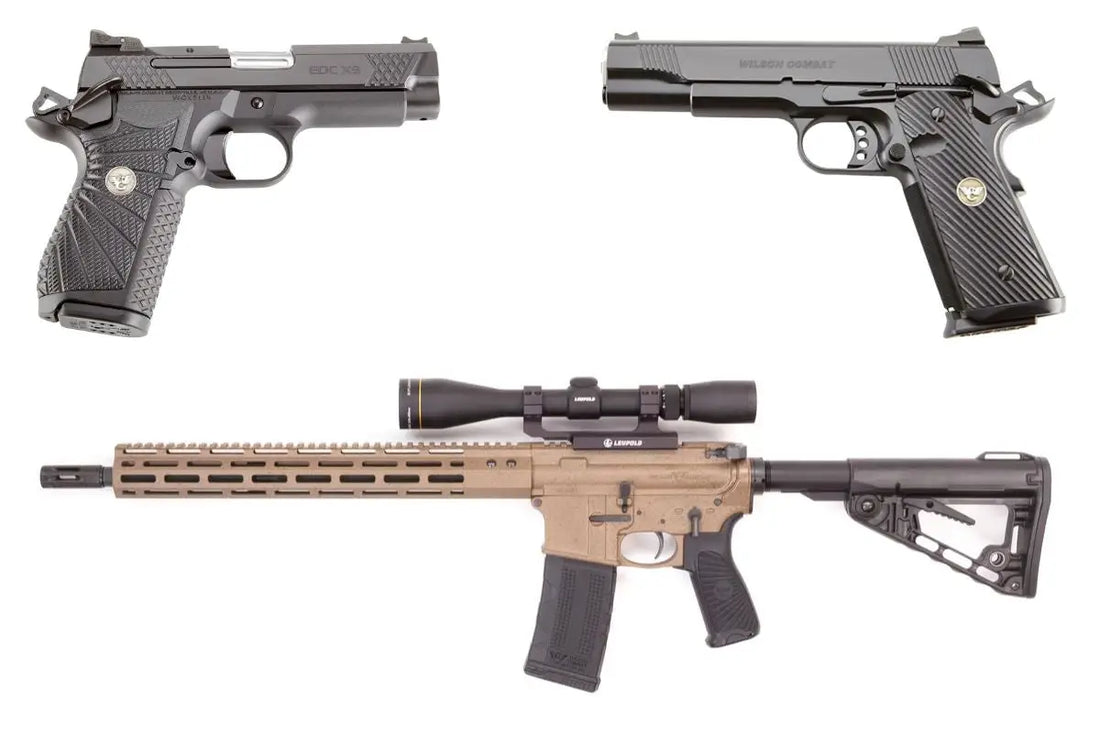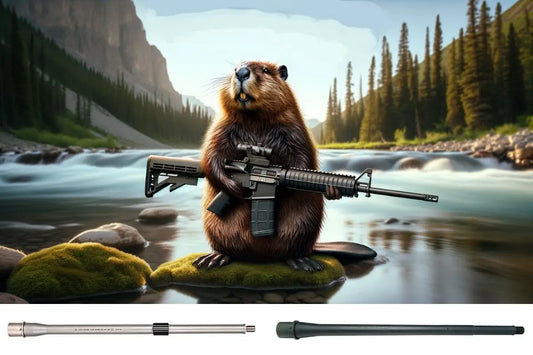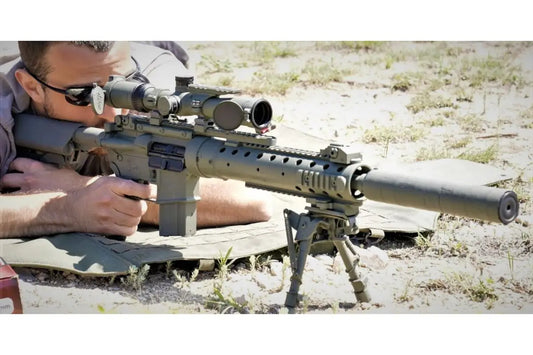
Wilson Combat: from 10' × 20' to benchmark brand
When Bill Wilson opened Wilson’s Gun Shop behind his father’s jewelry store in Berryville, Arkansas, in 1977, he was simply funding a practical‑pistol habit. Forty‑eight years later the company that now bears his name—Wilson Combat—employs hundreds, occupies three states, and ships premium firearms to elite units and everyday citizens around the globe. “It’s hard to believe the one‑man shop I started … has grown to a multi‑brand enterprise with over 200 employees,” Wilson said during the firm’s 45th‑anniversary celebration.
The story of that growth is also the story of modern custom‑gun culture. The 11 milestones below explain not only how Wilson Combat evolved but why its pistols, rifles and scatterguns still dominate conversations about accuracy, reliability and customer service.
1. 1977‑1982 | The jewelry‑store workshop that birthed a legend
Bill Wilson’s earliest jobs were reliability packages on Colt Government Models, Smith & Wesson PPC revolvers, and Ruger Super Blackhawks. Competitive shooting taught him that tolerances and trigger pulls win matches, and word of his one‑inch‑at‑25‑yards guarantee spread fast. By 1980 the gunsmith had a backlog and a first catalog; by 1982 he was already experimenting with proprietary sights and safeties—foreshadowing a jump from modifier to manufacturer.
2. 1983‑1995 | “Make every critical part yourself”
In 1983 Wilson stopped buying aftermarket components and began machining his own hammers, extractors and beavertails. Twelve years later every component of the flagship CQB .45 ACP was built in‑house, giving the company total control of metallurgy and fit. That move anchored two Wilson hallmarks:
- Tight, repeatable tolerances—achieved with CNCs but finished by hand lapping.
- A written one‑inch guarantee—still printed on invoices today.
Shooters such as Rob Leatham and Ken Hackathorn used early Wilsons to dominate IPSC and (later) found the International Defensive Pistol Association (IDPA), ensuring that “Wilson Combat” became synonymous with match wins.
3. 2000 | Buying Scattergun Technologies and conquering the pump shotgun
Wilson Combat’s first acquisition was Tennessee‑based Scattergun Technologies, maker of hardcore Remington 870 fighting shotguns. Models like the Border Patrol instantly became agency favorites. In a stress test for The Truth About Guns, the reviewer “smacked it around … dropped it butt‑first … It never had any issues,” awarding five stars for reliability.
The buyout diversified Wilson’s portfolio and transferred its 1911 philosophy—reliability is king—to the scattergun world.
4. 2001‑2014 | Building ARs that competitors called “too pretty to run” … until they ran
Wilson’s next frontier was the AR‑15 platform. Early rifles such as the Recon Tactical impressed hunters, but the game‑changer was the Protector Series. Despite being the company’s “budget” AR, it ships with a two‑stage trigger, BCM furniture and sub‑MOA barrel. Guns.com concluded: “A quality rifle that will stand the test of time—home defense to 3‑Gun.” Guns.com
Even internet skeptics concede that Wilson barrels shoot. One AR‑15 forum user noted: “Their barrels are excellent and very accurate … never had an issue with their BCGs either.”
5. 2015 | Collaboration culture—Beretta 92G Brigadier Tactical
Wilson’s first major OEM partnership produced the Beretta 92G Brigadier Tactical, merging Italian ergonomics with Arkansas machining. Features include a decocker‑only slide, steel guide rod and Wilson G‑10 stocks. Accuracy claims were proven when a tester printed a 15‑round, one‑inch group at ten yards.
The success of the 92G paved the way for Wilson’s custom treatment to SIG Sauer P320s, Glock 19/17s (Paul Howe edition) and Beretta 92X RDOs, letting the brand tap markets beyond the 1911 crowd without diluting its identity.
6. 2017 | Double‑stack revolution—the EDC X9 and SFT9
While polymer competitors fought for capacity, Bill Wilson re‑imagined the 1911’s ergonomics around a double‑stack, 15‑round magazine. The result was the EDC X9 and later the monolithic‑frame SFT9. USCCA called the X9 “a practical and versatile shooting implement … a testament to Wilson Combat’s 46‑year legacy.” USCCA
A 1,000‑round user report on 1911Addicts summed up customer sentiment: “It’s 100 percent—almost boring—reliability. Bill Wilson’s philosophy is that reliability is king … This one goes BANG every time.”
7. 2018‑2023 | Inventing cartridges—.300 HAM’R and the big‑bore renaissance
Dissatisfied with both .300 Blackout and 7.62×39 for medium‑game hunting, Wilson designed the .300 HAM’R: a 110‑ to 150‑grain, 2,600 fps thumper that drops hogs inside 400 yards. American Rifleman credits Bill for “wringing as much down‑range energy as possible out of an AR‑15 length case.”
Factory ammunition, barrels and complete rifles followed, proving that Wilson Combat is not just a gunmaker but a ballistic R&D house.
8. Craftsmanship that blends hand and machine
Walk the Berryville floor and you’ll see $500‑k CNCs cutting slides to ±0.0005‑inch, then veteran pistol smiths match‑surface rails with 600‑grit stones. Every gun is:
- Test‑fired for function and accuracy.
- Armor‑Tuff coated (or left stainless) for corrosion resistance.
- Signed by the finishing gunsmith.
That hybrid workflow allows Wilson to scale without sacrificing the “one‑gun, one‑smith” aura prized by collectors—and justifies prices that start around $3 K.
9. “Reliability is king”—the unbreakable brand promise
Bill Wilson has repeated the phrase in interviews for decades, and reviewers echo it verbatim. A 1911Addicts range report quotes him directly: “A pistol that doesn’t go bang every time … is worse than useless.”
Lifetime customer service backs the claim. Wilson Combat will refit, re‑crown or re‑finish a pistol long after the warranty expires—a policy quietly advertised as “The Forever Guarantee.”
10. Community, training and content marketing
Wilson knows that shooters listen to shooters, not glossy ads. So, the company:
- Co‑founded IDPA, boosting practical‑pistol demand.
- Hosts the “Gun Guys” YouTube series with Ken Hackathorn, giving customers weekly gunsmithing and tactics content.
- Sponsors military legends like Delta vet Paul Howe, whose G19 V2 package remains a top seller.
The result is a tribe that voluntarily evangelizes the brand online and at ranges worldwide.
11. Relentless iteration—why Wilson Combat keeps winning
Whether it’s the Model 47 magazine (still the gold standard for 1911 reliability), the Track‑Lock ghost‑ring shotgun sights, or the recent Optic‑Ready slides with proprietary plates, Wilson Combat learns from customer requests and ships improvements faster than bigger rivals. Acquisitions such as Lehigh Defense (maker of copper solid bullets) ensure a vertical pipeline of components and court‑proof supply chains.
As Bill Wilson told employees during a company town hall: “If we ever finish improving, we’re finished as a company.” That mindset—coupled with obsessive QC and best‑in‑class service—explains why special‑operations units, sheriff’s departments, USPSA grand masters and back‑forty deer hunters all trust the flying‑eagle logo.
Conclusion – lessons from Berryville
Wilson Combat’s timeline reads like a firearms MBA curriculum:
- Own your tolerances—start by making parts.
- Diversify carefully—scatterguns and ARs, but only after mastering pistols.
- Collaborate without compromising—Beretta and SIG projects enhance, not dilute, the core brand.
- Keep listening—IDPA, YouTube Q&As and warranty returns all feed the next innovation cycle.
Most companies would be happy to dominate a single niche. Wilson Combat dominates three—handguns, long guns and shotguns—because it never lost the gunsmith’s paranoia that the next trigger pull must go bang.
Shop the full Wilson Combat lineup here ➜ Guns.com




